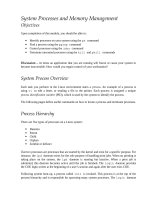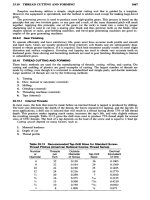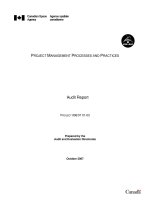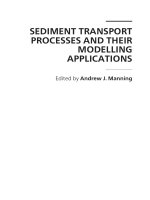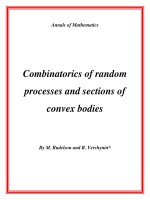Levy processes and Stochastics calculus
Bạn đang xem bản rút gọn của tài liệu. Xem và tải ngay bản đầy đủ của tài liệu tại đây (2.69 MB, 492 trang )
This page intentionally left blank
Lévy Processes and Stochastic Calculus
Second Edition
cam bridge s t u d i e s i n a d va n c e d m a t h e ma t i c s
Editorial Board
B. Bollobas, W. Fulton, A. Katok, F. Kirwan, P. Sarnak, B. Simon, B. Totaro
All the titles listed below can be obtained from good booksellers or from Cambridge University
Press. For a complete series listing visit: www.cambridge.org/series/sSeries.asp?code=CSAM
Already published
61
62
63
64
65
66
67
68
69
70
71
72
73
74
75
76
77
78
79
81
82
83
84
85
86
87
89
90
91
92
93
94
95
96
97
98
99
100
101
102
103
104
105
106
107
108
109
110
111
112
113
114
115
J. D. Dixon et al. Analytic pro-p groups
R. P. Stanley Enumerative combinatorics, II
R. M. Dudley Uniform central limit theorems
J. Jost & X. Li-Jost Calculus of variations
A. J. Berrick & M. E. Keating An introduction to rings and modules
S. Morosawa et al. Holomorphic dynamics
A. J. Berrick & M. E. Keating Categories and modules with K-theory in view
K. Sato Lévy processes and infinitely divisible distributions
H. Hida Modular forms and Galois cohomology
R. Iorio & V. Iorio Fourier analysis and partial differential equations
R. Blei Analysis in integer and fractional dimensions
F. Borceux & G. Janelidze Galois theories
B. Bollobás Random graphs
R. M. Dudley Real analysis and probability
T. Sheil-Small Complex polynomials
C. Voisin Hodge theory and complex algebraic geometry, I
C. Voisin Hodge theory and complex algebraic geometry, II
V. Paulsen Completely bounded maps and operator algebras
F. Gesztesy & H. Holden Soliton equations and their algebro-geometric solutions, I
S. Mukai An introduction to invariants and moduli
G. Tourlakis Lectures in logic and set theory, I
G. Tourlakis Lectures in logic and set theory, II
R. A. Bailey Association schemes
J. Carlson, S. Müller-Stach & C. Peters Period mappings and period domains
J. J. Duistermaat & J. A. C. Kolk Multidimensional real analysis, I
J. J. Duistermaat & J. A. C. Kolk Multidimensional real analysis, II
M. C. Golumbic & A. N. Trenk Tolerance graphs
L. H. Harper Global methods for combinatorial isoperimetric problems
I. Moerdijk & J. Mrcun Introduction to foliations and Lie groupoids
J. Kollár, K. E. Smith & A. Corti Rational and nearly rational varieties
D. Applebaum Lévy processes and stochastic calculus
B. Conrad Modular forms and the Ramanujan conjecture
M. Schechter An introduction to nonlinear analysis
R. Carter Lie algebras of finite and affine type
H. L. Montgomery & R.C Vaughan Multiplicative number theory, I
I. Chavel Riemannian geometry (2nd Edition)
D. Goldfeld Automorphic forms and L-functions for the group GL(n,R)
M. B. Marcus & J. Rosen Markov processes, Gaussian processes, and local times
P. Gille & T. Szamuely Central simple algebras and Galois cohomology
J. Bertoin Random fragmentation and coagulation Processes
E. Frenkel Langlands correspondence for loop groups
A. Ambrosetti & A. Malchiodi Nonlinear analysis and semilinear elliptic problems
T. Tao & V. H. Vu Additive combinatorics
E. B. Davies Linear operators and their spectra
K. Kodaira Complex analysis
T. Ceccherini-Silberstein, F. Scarabotti & F. Tolli Harmonic analysis on finite groups
H. Geiges An introduction to contact topology
J. Faraut Analysis on Lie groups
E. Park Complex topological K-theory
D. W. Stroock Partial differential equations for probabilists
A. Kirillov An introduction to Lie groups and Lie algebras
F. Gesztesy et al. Soliton equations and their algebro-geometric solutions, II
A. Iserles A first course in the numerical analysis of differential equations (2nd Edition)
Lévy Processes and Stochastic Calculus
Second Edition
DAVID APPLEBAUM
University of Sheffield
CAMBRIDGE UNIVERSITY PRESS
Cambridge, New York, Melbourne, Madrid, Cape Town, Singapore, São Paulo
Cambridge University Press
The Edinburgh Building, Cambridge CB2 8RU, UK
Published in the United States of America by Cambridge University Press, New York
www.cambridge.org
Information on this title: www.cambridge.org/9780521738651
© D. Applebaum 2009
This publication is in copyright. Subject to statutory exception and to the
provision of relevant collective licensing agreements, no reproduction of any part
may take place without the written permission of Cambridge University Press.
First published in print format 2009
ISBN-13
978-0-511-53384-6
eBook (EBL)
ISBN-13
978-0-521-73865-1
paperback
Cambridge University Press has no responsibility for the persistence or accuracy
of urls for external or third-party internet websites referred to in this publication,
and does not guarantee that any content on such websites is, or will remain,
accurate or appropriate.
To Jill
And lest I should be exalted above measure through the abundance of
revelations, there was given to me a thorn in the flesh, a messenger of Satan to
buffet me, lest I should be exalted above measure.
Second Epistle of St Paul to the Corinthians, Chapter 12
The more we jump – the more we get – if not more quality, then at least more
variety. James Gleick Faster
Contents
Preface to Second Edition
Preface
Overview
Notation
1
1.1
1.2
1.3
1.4
1.5
1.6
1.7
page xiii
xv
xxi
xxix
Lévy processes
Review of measure and probability
Infinite divisibility
Lévy processes
Convolution semigroups of probability measures
Some further directions in Lévy processes
Notes and further reading
Appendix: An exercise in calculus
1
1
21
43
62
67
78
80
Martingales, stopping times and random measures
Martingales
Stopping times
The jumps of a Lévy process – Poisson random
measures
2.4 The Lévy–Itô decomposition
2.5 Moments of Lévy Processes
2.6 The interlacing construction
2.7 Semimartingales
2.8 Notes and further reading
2.9 Appendix: càdlàg functions
2.10 Appendix: Unitary action of the shift
82
83
91
2
2.1
2.2
2.3
ix
99
112
131
133
137
138
139
141
x
3
3.1
Contents
143
3.6
3.7
3.8
Markov processes, semigroups and generators
Markov processes, evolutions
and semigroups
Semigroups and their generators
Semigroups and generators of Lévy processes
Lp -Markov semigroups
Lévy-type operators and the positive
maximum principle
Dirichlet forms
Notes and further reading
Appendix: Unbounded operators in Banach spaces
4
4.1
4.2
4.3
4.4
4.5
Stochastic integration
Integrators and integrands
Stochastic integration
Stochastic integrals based on Lévy processes
Itô’s formula
Notes and further reading
214
214
221
229
243
279
5
Exponential martingales, change of measure and financial
applications
Stochastic exponentials
Exponential martingales
Martingale representation theorems
Multiple Wiener–Lévy Integrals
Introduction to Malliavin Calculus
Stochastic calculus and mathematical finance
Notes and further reading
Appendix: Bessel functions
Appendix: A density result
280
281
285
299
306
317
324
348
348
351
3.2
3.3
3.4
3.5
5.1
5.2
5.3
5.4
5.5
5.6
5.7
5.8
5.9
6
6.1
6.2
6.3
6.4
6.5
6.6
6.7
Stochastic differential equations
Differential equations and flows
Stochastic differential equations – existence and uniqueness
Examples of SDEs
Stochastic flows, cocycle and Markov properties of SDEs
Interlacing for solutions of SDEs
Continuity of solution flows to SDEs
Solutions of SDEs as Feller processes, the
Feynman–Kac formula and martingale problems
143
153
160
172
180
189
200
201
354
355
363
377
383
392
395
399
Contents
Lyapunov exponents for stochastic
differential equations
6.9 Densities for Solutions of SDEs
6.10 Marcus canonical equations
6.11 Notes and further reading
xi
6.8
References
Index of notation
Subject index
411
415
417
426
431
449
454
Preface to Second Edition
It is four years since the first version of this book appeared and there has continued to be intense activity focused on Lévy processes and related areas. One
way of gauging this is to look at the number of books and monographs which
have appeared in this time. Regarding fluctuation theory of Lévy processes,
there is a new volume by A. Kyprianou [221] and the St Flour lectures of
R. Doney [96]. From the point of view of interactions with analysis, N. Jacob
has published the third and final volume of his impressive trilogy [182]. Applications to finance has continued to be a highly active and fast moving area and
there are two new books here – a highly comprehensive and thorough guide
by R. Cont and P. Tankov [81] and a helpful introduction aimed at practioners
from W.Schoutens [329]. There have also been new editions of classic texts by
Jacod and Shiryaev [183] and Protter [298].
Changes to the present volume are of two types. On the one hand there was
the need to correct errors and typos and also to make improvements where this
was appropriate. In this respect, I am extremely grateful to all those readers who
contacted me with remarks and suggestions. In particular I would like to thank
Fangjun Xu, who is currently a first-year graduate student at Nanzai University,
who worked through the whole book with great zeal and provided me with an
extremely helpful list of typos and mistakes. Where there were more serious
errors, he took the trouble to come up with his own proofs, all of which were
correct.
I have also included some new material, particularly where I think that the
topics are important for future work. These include the following. Chapter 1 now
has a short introductory section on regular variation which is the main tool in the
burgeoning field of ‘heavy tailed modelling’. In Chapter 2, there is additional
material on bounded variation Lévy processes and on the existence of moments
for Lévy processes. Chapter 4 includes new estimates on moments of Lévy-type
stochastic integrals which have recently been obtained by H. Kunita [218]. In
xiii
xiv
Preface to Second Edition
Chapter 5, I have replaced the proof of the Itô and martingale representation
theorem which was previously given only in the Brownian motion case, with
one that works for general Lévy processes. I then develop the theory of multiple Wiener–Itô integrals (again in the general context) and apply the martingale
representation theorem to prove Itô’s result on chaos decomposition. I have also
included a short introduction to Malliavin calculus, albeit only in the Brownian
case, as this is now an area of intense activity which extends from quite abstract
path space analysis and geometry to option pricing. As it is quite extensively
dealt with in Cont and Tankov [81] and Schoutens [329], I resisted the temptation to include more material on mathematical finance with one exception – a
natural extension of the Black–Scholes pde to include jump terms now makes
a brief entrance on to the stage. In Chapter 6, the rather complicated proof of
continuity of solutions of SDEs with respect to their initial conditions has been
replaced by a new streamlined version due to Kunita [218] and employing his
estimates on stochastic integrals mentioned above. There is also a new section
on Lyapunov exponents for SDEs which opens the gates to the study of their
asymptotic stability. Once again it is a pleasure to thank Fangjun Xu who carefully read and commented on all of this material. The statutory free copy of
the book will be small recompense for his labours. I would also like to thank
N.H. Bingham and H. Kunita for helpful remarks and my student M. Siakalli
for some beneficial discussions. Cambridge University Press have continued
to offer superb support and I would once again like to thank my editor David
Tranah and all of his staff, particularly Peter Thompson who took great pains
in helping me navigate through the elaborate system of CUP-style LaTeX.
Of course the ultimate responsibility for any typos and more serious
errors is mine. Readers are strongly encouraged to continue to send them to
me at d.applebaum@sheffield.ac.uk. They will be posted on my website at
/>
Preface
The aim of this book is to provide a straightforward and accessible introduction to stochastic integrals and stochastic differential equations driven by Lévy
processes.
Lévy processes are essentially stochastic processes with stationary and independent increments. Their importance in probability theory stems from the
following facts:
• they are analogues of random walks in continuous time;
• they form special subclasses of both semimartingales and Markov processes
for which the analysis is on the one hand much simpler and on the other hand
provides valuable guidance for the general case;
• they are the simplest examples of random motion whose sample paths are
right-continuous and have a number (at most countable) of random jump
discontinuities occurring at random times, on each finite time interval.
• they include a number of very important processes as special cases, including Brownian motion, the Poisson process, stable and self-decomposable
processes and subordinators.
Although much of the basic theory was established in the 1930s, recent
years have seen a great deal of new theoretical development as well as novel
applications in such diverse areas as mathematical finance and quantum field
theory. Recent texts that have given systematic expositions of the theory have
been Bertoin [39] and Sato [323]. Samorodnitsky and Taqqu [319] is a bible for
stable processes and related ideas of self-similarity, while a more applicationsoriented view of the stable world can be found in Uchaikin and Zolotarev
[350]. Analytic features of Lévy processes are emphasised in Jacob [179, 180].
A number of new developments in both theory and applications are surveyed
in the volume [26].
xv
xvi
Preface
Stochastic calculus is motivated by the attempt to understand the behaviour
of systems whose evolution in time X = (X (t), t ≥ 0) contains both deterministic and random noise components. If X were purely deterministic then
three centuries of calculus have taught us that we should seek an infinitesimal
description of the way X changes in time by means of a differential equation
dX (t)
= F(t, X (t))dt.
dt
If randomness is also present then the natural generalisation of this is a stochastic
differential equation:
dX (t) = F(t, X (t))dt + G(t, X (t))dN (t),
where (N (t), t ≥ 0) is a ‘driving noise’.
There are many texts that deal with the situation where N (t) is a Brownian motion or, more generally, a continuous semimartingale (see e.g. Karatzas
and Shreve [200], Revuz and Yor [306], Kunita [215]). The only volumes that
deal systematically with the case of general (not necessarily continuous) semimartingales are Protter [298], Jacod and Shiryaev [183], Métivier [262] and,
more recently, Bichteler [47]; however, all these make heavy demands on the
reader in terms of mathematical sophistication. The approach of the current
volume is to take N (t) to be a Lévy process (or a process that can be built from
a Lévy process in a natural way). This has two distinct advantages:
• The mathematical sophistication required is much less than for general semi-
martingales; nonetheless, anyone wanting to learn the general case will find
this a useful first step in which all the key features appear within a simpler
framework.
• Greater access is given to the theory for those who are only interested in
applications involving Lévy processes.
The organisation of the book is as follows. Chapter 1 begins with a brief
review of measure and probability. We then meet the key notions of infinite
divisibility and Lévy processes. The main aim here is to get acquainted with
the concepts, so proofs are kept to a minimum. The chapter also serves to
provide orientation towards a number of interesting theoretical developments
in the subject that are not essential for stochastic calculus.
In Chapter 2, we begin by presenting some of the basic ideas behind stochastic
calculus, such as filtrations, adapted processes and martingales. The main aim is
to give a martingale-based proof of the Lévy–Itô decomposition of an arbitrary
Lévy process into Brownian and Poisson parts. We then meet the important idea
Preface
xvii
of interlacing, whereby the path of a Lévy process is obtained as the almost-sure
limit of a sequence of Brownian motions with drift interspersed with jumps of
random size appearing at random times.
Chapter 3 aims to move beyond Lévy processes to study more general Markov
processes and their associated semigroups of linear mappings. We emphasise,
however, that the structure of Lévy processes is the paradigm case and this is
exhibited both through the Courrège formula for the infinitesimal generator of
Feller processes and the Beurling–Deny formula for symmetric Dirichlet forms.
This chapter is more analytical in flavour than the rest of the book and makes
extensive use of the theory of linear operators, particularly those of pseudodifferential type. Readers who lack background in this area can find most of
what they need in the chapter appendix.
Stochastic integration is developed in Chapter 4. A novel aspect of our
approach is that Brownian and Poisson integration are unified using the idea of
a martingale-valued measure. At first sight this may strike the reader as technically complicated but, in fact, the assumptions that are imposed ensure that
the development remains accessible and straightforward. A highlight of this
chapter is the proof of Itô’s formula for Lévy-type stochastic integrals.
The first part of Chapter 5 deals with a number of useful spin-offs from
stochastic integration. Specifically, we study the Doléans-Dade stochastic exponential, Girsanov’s theorem and its application to change of measure, the
Cameron–Martin formula and the beginnings of analysis in Wiener space and
martingale representation theorems. Most of these are important tools in mathematical finance and the latter part of the chapter is devoted to surveying the
application of Lévy processes to option pricing, with an emphasis on the specific goal of finding an improvement to the celebrated but flawed Black–Scholes
formula generated by Brownian motion. At the time of writing, this area is
evolving at a rapid pace and we have been content to concentrate on one
approach using hyperbolic Lévy processes that has been rather well developed. We have included, however, a large number of references to alternative
models.
Finally, in Chapter 6, we study stochastic differential equations driven by
Lévy processes. Under general conditions, the solutions of these are Feller
processes and so we gain a concrete class of examples of the theory developed
in Chapter 3. Solutions also give rise to stochastic flows and hence generate
random dynamical systems.
The book naturally falls into two parts. The first three chapters develop the
fundamentals of Lévy processes with an emphasis on those that are useful in
stochastic calculus. The final three chapters develop the stochastic calculus of
Lévy processes.
xviii
Preface
Each chapter closes with some brief historical remarks and suggestions for
further reading. I emphasise that these notes are only indicative; no attempt has
been made at a thorough historical account, and in this respect I apologise to
any readers who feel that their contribution is unjustly omitted. More thorough
historical notes in relation to Lévy processes can be found in the chapter notes
to Sato [323], and for stochastic calculus with jumps see those in Protter [298].
This book requires background knowledge of probability and measure theory
(such as might be obtained in a final-year undergraduate mathematics honours
programme), some facility with real analysis and a smattering of functional
analysis (particularly Hilbert spaces). Knowledge of basic complex variable
theory and some general topology would also be an advantage, but readers
who lack this should be able to read on without too much loss. The book is
designed to be suitable for underpinning a taught masters level course or for
independent study by first-year graduate students in mathematics and related
programmes. Indeed, the two parts would make a nice pair of linked half-year
modules. Alternatively, a course could also be built from the core of the book,
Chapters 1, 2, 4 and 6. Readers with a specific interest in finance can safely
omit Chapter 3 and Section 6.4 onwards, while analysts who wish to deepen
their understanding of stochastic representations of semigroups might leave out
Chapter 5.
A number of exercises of varying difficulty are scattered throughout the text.
I have resisted the temptation to include worked solutions, since I believe that
the absence of these provides better research training for graduate students.
However, anyone having persistent difficulty in solving a problem may contact
me by e-mail or otherwise.
I began my research career as a mathematical physicist and learned modern
probability as part of my education in quantum theory. I would like to express
my deepest thanks to my teachers Robin Hudson, K.R. Parthasarathy and Luigi
Accardi for helping me to develop the foundations on which later studies have
been built. My fascination with Lévy processes began with my attempt to understand their wonderful role in implementing cocycles by means of annihilation,
creation and conservation processes associated with the free quantum field, and
this can be regarded as the starting point for quantum stochastic calculus. Unfortunately, this topic lies outside the scope of this volume but interested readers
can consult Parthasarathy [291], pp. 152–61 or Meyer [267], pp. 120–1.
My understanding of the probabilistic properties of Lévy processes has deepened as a result of work in stochastic differential equations with jumps over
the past 10 years, and it is a great pleasure to thank my collaborators Hiroshi
Kunita, Serge Cohen, Anne Estrade, Jiang-Lun Wu and my student Fuchang
Tang for many joyful and enlightening discussions. I would also like to thank
Preface
xix
René Schilling for many valuable conversations concerning topics related to
this book. It was he who taught me about the beautiful relationship with pseudodifferential operators, which is described in Chapter 3. Thanks are also due to
Jean Jacod for clarifying my understanding of the concept of predictability and
to my colleague Tony Sackfield for advice about Bessel functions.
Earlier versions of this book were full of errors and misunderstandings and
I am enormously indebted to Nick Bingham, Tsukasa Fujiwara, Fehmi Özkan
and René Schilling, all of whom devoted the time and energy to read extensively and criticize early drafts. Some very helpful comments were also made
by Krishna Athreya, Ole Barndorff-Nielsen, Uwe Franz, Vassili Kolokoltsov,
Hiroshi Kunita, Martin Lindsay, Nikolai Leonenko, Carlo Marinelli (particularly with regard to LaTeX) and Ray Streater. Nick Bingham also deserves a
special thanks for providing me with a valuable tutorial on English grammar.
Many thanks are also due to two anonymous referees employed by Cambridge University Press. The book is greatly enriched thanks to their perceptive
observations and insights.
In March 2003, I had the pleasure of giving a course, partially based on
this book, at the University of Greifswald, as part of a graduate school on
quantum independent increment processes. My thanks go to the organisers,
Michael Schürmann and Uwe Franz, and all the participants for a number of
observations that have improved the manuscript.
Many thanks are also due to David Tranah and the staff at Cambridge University Press for their highly professional yet sensitive management of this
project.
Despite all this invaluable assistance, some errors surely still remain and the
author would be grateful to be e-mailed about these at
Corrections received after publication will be posted on his website
/>1 Note added in second edition. This website is no longer active. The relevant address is now
/>
Overview
It can be very useful to gain an intuitive feel for the behaviour of Lévy processes and the purpose of this short introduction is to try to develop this. Of
necessity, our mathematical approach here is somewhat naive and informal –
the structured, rigorous development begins in Chapter 1.
Suppose that we are given a probability space ( , F, P). A Lévy process
X = (X (t), t ≥ 0) taking values in Rd is essentially a stochastic process having
stationary and independent increments; we always assume that X (0) = 0 with
probability 1. So:
• each X (t) : → Rd ;
• given any selection of distinct time-points 0 ≤ t1 < t2 < · · · < tn , the
random vectors X (t1 ), X (t2 ) − X (t1 ), X (t3 ) − X (t2 ), . . . , X (tn ) − X (tn−1 )
are all independent;
• given any two distinct times 0 ≤ s < t < ∞, the probability distribution of
X (t) − X (s) coincides with that of X (t − s).
The key formula in this book from which so much else flows, is the magnificent Lévy–Khintchine formula, which says that any Lévy process has a specific
form for its characteristic function. More precisely, for all t ≥ 0, u ∈ Rd ,
E(ei(u,X (t)) ) = etη(u)
(0.1)
where
1
ei(u,y) − 1 − i(u, y)χ0<|y|<1 (y) ν(dy).
η(u) = i(b, u) − (u, au) +
d
2
R −{0}
(0.2)
In this formula b ∈ Rd , a is a positive definite symmetric d × d matrix and ν
is a Lévy measure on Rd − {0}, so that Rd −{0} min{1, |y|2 }ν(dy) < ∞. If you
xxi
xxii
Overview
have not seen it before, (0.2) will look quite mysterious to you, so we need to
try to extract its meaning.
First suppose that a = ν = 0; then (0.1), just becomes E(ei(u,X (t)) ) = eit(u,b) ,
so that X (t) = bt is simply deterministic motion in a straight line. The vector
b determines the velocity of this motion and is usually called the drift.
Now suppose that we also have a = 0, so that (0.1) takes the form
E(ei(u,X (t)) ) = exp{t[i(b, u) − 12 (u, au)]}. We can recognise this as the characteristic function of a Gaussian random variable X (t) having mean vector
tb and covariant matrix ta. In fact we can say more about this case: the process (X (t), t ≥ 0) is a Brownian motion with drift, and such processes have
been extensively studied for over 100 years. In particular, the sample paths
t → X (t)(ω) are continuous (albeit nowhere differentiable) for almost all
ω ∈ . The case b = 0, a = I is usually called standard Brownian motion.
Now consider the case where we also have ν = 0. If ν is a finite measure we
can rewrite (0.2) as
η(u) = i(b , u) − 12 (u, au) +
where b = b −
0<|y|<1 yν(dy). We
Rd −{0}
(ei(u,y) − 1)ν(dy),
will take the simplest possible form for ν,
i.e. ν = λδh where λ > 0 and δh is a Dirac mass concentrated at h ∈ Rd − {0}.
√
In this case we can set X (t) = b t + aB(t) + N (t), where B = (B(t), t ≥ 0)
is a standard Brownian motion and N = (N (t), t ≥ 0) is an independent process
for which
E(ei(u,N (t)) ) = exp λt(ei(u,h) − 1) .
We can now recognise N as a Poisson process of intensity λ taking values in
the set {nh, n ∈ N}, so that P(N (t) = nh) = e−λt [(λt)n /n!] and N (t) counts
discrete events that occur at the random times (Tn , n ∈ N). Our interpretation of
the paths of X in this case is now as follows. X follows the path of a Brownian
motion with drift from time zero until the random time T1 . At time T1 the path
has a jump discontinuity of size |h|. Between T1 and T2 we again see Brownian
motion with drift, and there is another jump discontinuity of size |h| at time T2 .
We can continue to build the path in this manner indefinitely.
d
The next stage is to take ν = m
i=1 λi δhi , where m ∈ N, λi > 0 and hi ∈ R −
{0}, for 1 ≤ i ≤ m. We can then write
X (t) = b t +
√
aB(t) + N1 (t) + · · · + Nm (t),
Overview
xxiii
where N1 , . . . , Nm are independent Poisson processes (which are also independent of B); each Ni has intensity λi and takes values in the set {nhi , n ∈ N} where
1 ≤ i ≤ m. In this case, the path of X is again a Brownian motion with drift,
interspersed with jumps taking place at random times. This time, though, each
jump size may be any of the m numbers |h1 |, . . . , |hm |.
In the general case where ν is finite, we can see that we have passed to the
limit in which jump sizes take values in the full continuum of possibilities,
corresponding to a continuum of Poisson processes. So a Lévy process of this
type is a Brownian motion with drift interspersed with jumps of arbitrary size.
Even when ν fails to be finite, if we have 0<|x|<1 |x|ν(dx) < ∞ a simple
exercise in using the mean value theorem shows that we can still make this
interpretation.
The most subtle case of the Lévy–Khintchine formula (0.2) is when
2
0<|x|<1 |x|ν(dx) = ∞ but 0<|x|<1 |x| ν(dx) < ∞. Thinking analytically,
ei(u,y) − 1 may no longer be ν-integrable but
ei(u,y) − 1 − i(u, y)χ0<|y|<1 (y)
always is. Intuitively, we may argue that the measure ν has become so fine that
it is no longer capable of distinguishing small jumps from drift. Consequently it
is necessary to amalgamate them together under the integral term. Despite this
subtlety, it is still possible to interpret the general Lévy process as a Brownian
motion with drift b interspersed with ‘jumps’ of arbitrary size, provided we
recognise that at the microscopic level tiny jumps and short bursts of drift
are treated as one. A more subtle discussion of this, and an account of the
phenomenon of ‘creep’, can be found at the end of Section 2.4. We will see in
Chapter 2 that the path can always be constructed as the limit of a sequence of
terms, each of which is a Brownian motion with drift interspersed with bona
fide jumps.
When ν < ∞, we can write the sample-path decomposition directly as
X (t) = bt +
√
aB(t) +
X (s),
(0.3)
0≤s≤t
where X (s) is the jump at time s (e.g. if ν = λδh then X (s) = 0 or h).
Instead of dealing directly with the jumps it is more convenient to count the
times at which the jumps occur, so for each Borel set A in Rd − {0} and for
each t ≥ 0 we define
N (t, A) = #{0 ≤ s ≤ t; X (s) ∈ A}.
